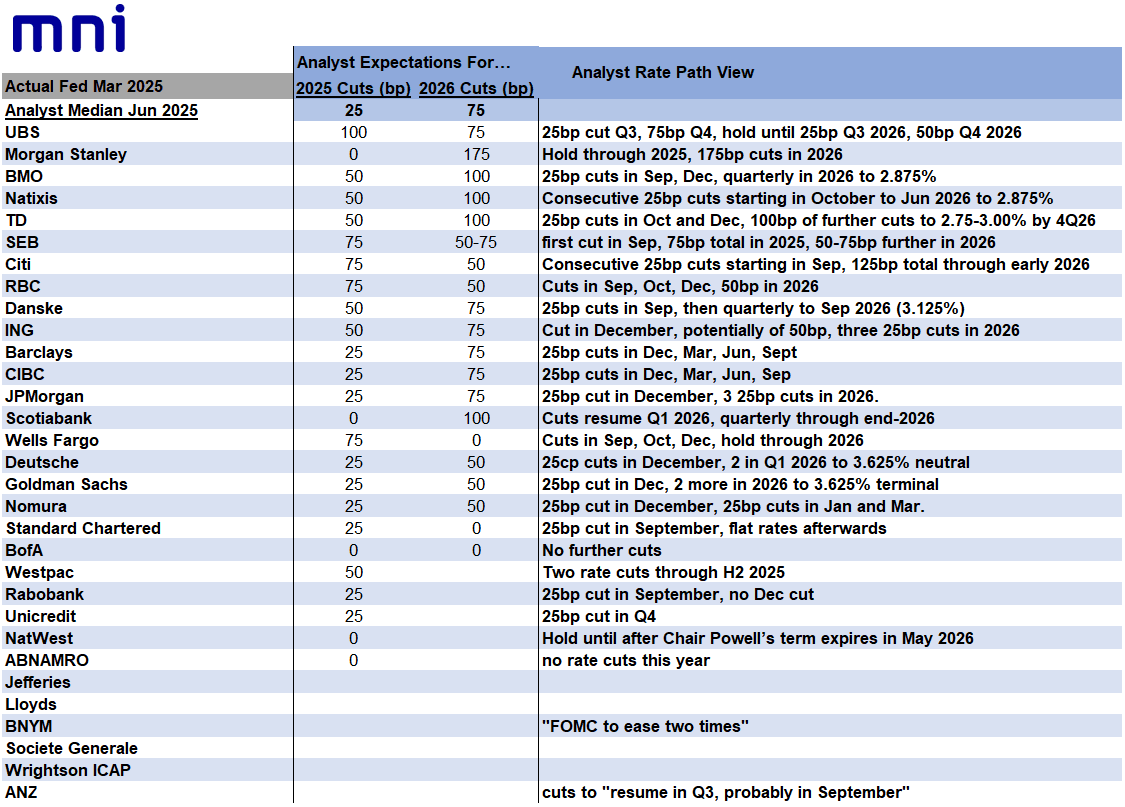USDCAD TECHS: Trend Signals Remain Bearish
Jul-16 20:00
* RES 4: 1.3920 High May 21 * RES 3: 1.3862 High May 29 * RES 2: 1.3798 High Jun 23 * RES 1: 1.3749 ...
Want to read more?
Find more articles and bullets on these widgets:
Historical bullets
FED: Instant Answers For June FOMC Meeting
Jun-16 19:56
The Instant Answers questions that we have selected for the June FOMC statement and projections are as follows (due to be released at 1400ET Wednesday):
- Federal Funds Rate Range Maximum
- Number of dissenters on size of rate move
- Median Projection of Fed Funds Rate at End of 2025
- Median Projection of Fed Funds Rate at End of 2026
- Median Longer Run Projection of Fed Funds Rate
- Number of 2025 Dots > 4.375%
- Number of 2025 Dots > 4.125%
- Number of 2025 Dots > 3.875%
- Number of 2025 Dots < 3.875%
FED: Analysts See 0 To 100bp Of Cuts This Year, Up To 175bp Through 2026 (2/2)
Jun-16 19:51
Going into the June FOMC meeting, the median analyst is forecasting the Fed to deliver just 1 cut this year for 25bp of easing, but there is a wide range of opinions which includes 100bp of cuts (UBS) to zero (multiple). See table below.
- Opinion is accordingly split among most analysts about whether the next cut is in September, October, or December.
- The median analyst expectation is for 75bp of cuts in 2026, though again this ranges from no cuts to 175bp of easing (Morgan Stanley).
- The median analyst who has forecasts through both years sees 112.5bp of cuts, or between 4-5.
- UBS and Morgan Stanley see the most total easing (175bp), while BofA sees no further cuts.

US OUTLOOK/OPINION: Macro Since Last FOMC: Labor - Wages Surprise Hotter
Jun-16 19:49
- On the flip side, wage growth has also started to come in hotter. We wouldn’t put too much weight on the surprisingly strong 0.42% M/M increase in average hourly earnings in May in isolation but it followed a strong 6.6% annualized increase in unit labor costs in Q1 (strongest since 1Q24 and before that 3Q22).
- Productivity growth played a role here, falling -1.5% annualized for its first decline since 2Q22 after a period of some particularly strong gains, but the underlying wage growth series was still strong.
- Whilst Powell has previously said he doesn’t expect inflationary pressures to come from the labor market, wage growth is starting to warrant closer inspection.